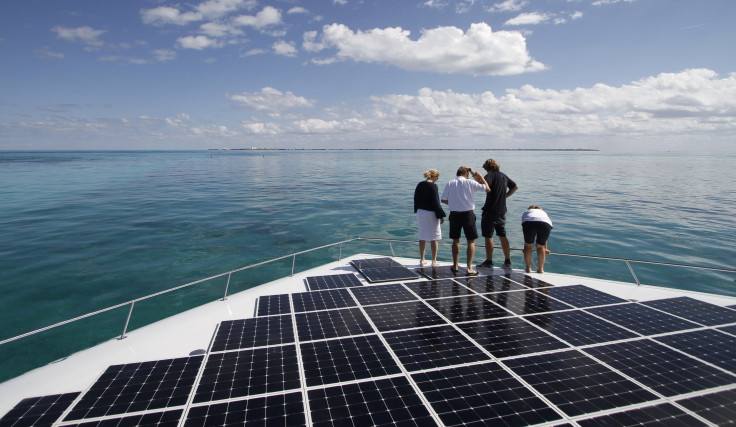US Can Slash Its Fossil Fuel Emissions By 85 Percent By 2050, New Climate Change Study Shows

In America’s low-carbon future, most cars will run on electricity, carbon dioxide will be stored underground, and homes and buildings will be hyper-efficient, guzzling less energy even as the population grows. This is the vision of a new analysis that maps how the United States can drastically curb its greenhouse gas emissions by 2050.
The plan, unveiled this week, is part of the United Nations' Deep Decarbonization Pathways Project, which aims to figure out how each country should act to limit global warming to less than 2 degrees Celsius (3.6 degrees Fahrenheit) above preindustrial levels -- the level at which scientists say we can avoid the most catastrophic effects of climate change.
The project was born out of climate experts’ frustrations that, even as governments pledged to address climate change, “not a lot of people were doing the homework. So we said, ‘Let’s do it. Let’s take it seriously,’ ” Emmanuel Guerin, who manages the project for the U.N.’s Sustainable Development Solutions Network, said in a September interview ahead of the New York climate change summit.
Guerin’s team developed individual strategies for 15 countries, including the U.S., U.K., China, Russia and Brazil. Together, the group’s carbon footprint equals about 70 percent of the world’s total emissions.
The U.S. strategy would reduce America’s carbon emissions from burning fossil fuels to less than 750 million metric tons in 2050 -- an 85 percent drop from 1990 levels. While the report doesn’t tally the costs of getting there, it does say that it’s possible to reach this goal using technologies and resources that exist today.
“Can we do it? The answer is yes,” Margaret Torn, a co-author of the report and a senior scientist at the Lawrence Berkeley National Laboratory in California, told the news organization Climate Central. She added that “this is the first analysis of its kind to look at how the U.S. might meet such a deep greenhouse gas reduction goal all the way to 2050.”
Achieving these emissions cuts will still require massive investment in the research, development and deployment of low-carbon technologies, many of which are still too expensive or fledgling to deploy on a wide scale. Carbon capture and storage (CCS), which involves trapping and burying carbon emissions from coal and natural gas plants, only appears in a few pilot projects in the United States. Battery-powered cars accounted for less than 4 percent of total auto sales last year as manufacturers struggled to convince consumers to ditch their gas-powered vehicles.
According to the report, “decarbonizing” the U.S. energy sector requires three main strategies:
- Boosting energy efficiency in buildings, cars and industrial facilities. Homes and office towers will be revamped to include leak-proof windows, thick insulation and superefficient LED lighting, the report says. Appliances, water heaters and air-conditioning systems will be upgraded to modern models with low energy appetites. Factories will capture all the heat they produce in churning out iron and steel and turn it into electricity. As a result of these improvements, “economic energy intensity” -- the amount of energy required for each unit of economic output -- will drop by nearly 75 percent, from 5.3 megajoules per dollar in 2010, to 1.3 megajoules in 2050.
- Cutting the carbon from electricity and other fuels. Today, fossil fuels make up nearly 70 percent of total U.S. electricity production, according to federal statistics. By 2050, however, coal and natural gas will make up just 30 percent of the mix -- and only if they include carbon capture and storage technology, which will limit their emissions impact, the report said. Fossil fuels without CCS will be gone. Renewable supplies -- including hydropower, solar, wind, biomass and geothermal -- will leap from just 15 percent of today’s mix to 40 percent in four decades. Nuclear power will rise slightly, from about 20 percent of the total to 30 percent. With these changes, electricity’s emissions intensity will drop a staggering 97 percent, from 605 grams of carbon for every kilowatt-hour of power, to just 18 units. At the same time America is producing cleaner power, it will also use more of it, as electricity replaces gasoline and industrial fuels. Researchers figure that net electricity generation will jump 75 percent above 2010 levels by 2050.
- Swapping other high-carbon fuels with low-carbon alternatives. Cars, trucks and other light-duty vehicles will run mostly on electricity and hydrogen fuel cells. But heavy-duty transportation, such as freight trucks, shipping barges and rail cars, aren’t expected to be able to run on battery packs. Instead, these vehicles and ships will use natural gas -- in a compressed or liquid form -- or biomass, which comes from a host of places, such as sewage water, wood scraps, manure and composted garbage. Petroleum won’t go away entirely, however. Airplanes, military vehicles and aircrafts and some types of trucks could still chug gasoline and diesel where other alternatives won’t work, the report said.
Guerin said the Deep Decarbonization team produced the country reports without help from the respective governments. “It was very important for us to conduct an independent research project, and keep the political considerations and disagreements away from the project,” he explained in the earlier interview. He said that once the report was released, the U.N. team would “have a conversation soon about the pathway the U.S. team produced” for the report.
Those talks will help government negotiators to prepare for a highly anticipated climate conference in Paris in December 2015, said Jeffrey Sachs, who directs the Earth Institute at Columbia University in New York and the U.N.’s sustainable development network.
“I believe that the report provides a solid basis for negotiating a strong climate treaty in Paris,” he said in a statement.
© Copyright IBTimes 2024. All rights reserved.



















